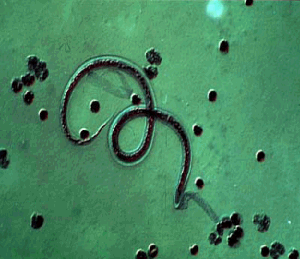 Lymphatic filariasis is a debilitating disease caused by nematode worms of the genera Wucheria and Brugia. Larval worms circulate in the bloodstream of infected persons, and adult worms live in the lymphatic vessels. Lymphatic filariasis is not life threatening, but it does cause discomfort, swelling of the limbs and genitals, damage to the kidneys and lymphatic system, impairment of the body's ability to fight infection, and general malaise. In addition, it causes immeasurable emotional and economic costs in terms of the disruption of family and community life.
Lymphatic filariasis is a debilitating disease caused by nematode worms of the genera Wucheria and Brugia. Larval worms circulate in the bloodstream of infected persons, and adult worms live in the lymphatic vessels. Lymphatic filariasis is not life threatening, but it does cause discomfort, swelling of the limbs and genitals, damage to the kidneys and lymphatic system, impairment of the body's ability to fight infection, and general malaise. In addition, it causes immeasurable emotional and economic costs in terms of the disruption of family and community life.Humans contract filariasis when they are bitten repeatedly by mosquitoes infected with filarial worms. Over 70 species of mosquitoes in the genera Culex, Anopheles, Aedes, and Mansoniacan infect humans with the disease. Mosquitoes pick up the tiny, microfilarial form of the parasite when taking blood meals from infected humans. In the mosquito, the microfilariae develop within 7-21 days into members of the next stage of the parasite's life cycle, which are known as filariform larva. The filariform larva are infective to humans. When the larval worms move to a mosquito's mouth, and then the mosquito bites humans, the parasites can spread through a human community. Fortunately, however, many bites from infected mosquitoes are required before a person is infected with the disease.
Once a human does pick up filariform larvae from mosquito bites, the larvae move to the lymphatic system, where they develop into adult worms. It usually takes 8-16 months after infection for symptoms of the disease to appear. The life span of adult worms is approximately seven years (microfilariae have a life span of from 3-36 months). The adults range in size from 2-50 cm in length. In the human, the adult worms mate and then the females produce millions of new microfilariae, which then circulate in the blood stream. Microfilariae circulating in the bloodstream can then be picked up by mosquitoes taking blood meals. In most endemic regions, microfilariae show peak abundance in the human bloodstream between 10 p.m. and 2 a.m., which corresponds with the time when Culex mosquitoes are most active. In some regions of the South Pacific, however, where the vectors of filariasis are active primarily in the daytime, microfilariae are most abundant during the day. These observations are consistent with the hypothesis that the microfilariae-abundance cycle in the bloodstream has evolved to maximize transmission to mosquitoes.
[External Links]
More Information from Boston College's website
More information from dhpe.org
More information from wrongdiagnosis.com




No comments:
Post a Comment